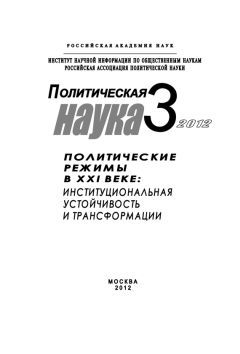911
Seward, The Future of Welfare Systems, p. 214, 218.
The Economist, 11 September 1993.
Congressional Budget Office, US House of Representatives, Ways and Means Committee «The Changing Distribution of Federal Taxes, 1977–1990,» February 1987; «Tax Progressivity and Income Distribution», 26 March 1990.
См.: Е. В. Kapstein «Workers and the World Economy,» Foreign Affairs, 73, 3, May/June 1996, p. 16–17.
По Соединенным Штатам см.: R. B. Freeman and L. F. Katz, eds., Differences and Changes in Wage Structures (Chicago: University of Chicago Press, 1995); о подобных изменениях, проходивших в Германии как крупнейшей стране ЕС, см. Der Spiegel, 39, 1997, p. 96ff.
Доступное перечисление идей Хайека: С. Nishiyama and K. L. Leube, eds. The Essence of Hayek (Stanford, CA: Hoover Institution Press, 1984).
См. удобный краткий обзор в сб.: P. J. Miller, ed., The Rational Expectations Revolutions (Cambridge, MA: MIT Press, 1994). Я хочу поблагодарить профессора X. Баркай экономического факультета Еврейского Университета за ключ к последним вывертам экономической теории.
См. напр.: R. L. Greenfield and L. В. Yeager, «A Laissez Faire Approach to Monetary Stability,» Journal of Money, Credit and Banking, 15, 1983, p. 302–315; L. H. White, «The Relevance of Free Banking Today,» in Collins, Central Banking in History, vol. I, p. 434–449; R. Vaubal, «The Government's Money Monopoly: Externalization of Natural Monopoly,» Kyklos, 37, 1984, p. 27–58; и прежде всего: Хайек Ф. Частные деньги. М.: ИНМЭ, 1996.
См.: R. Pryke, The Nationalized Industries: Policies and Performance Since 1968 (Oxford: Robertson, 1986), esp. p. 237–266.
Полный список полностью или частично проданных компаний, а также полученные суммы см. в: S. Chodak, The New State: Etatization of Western Societies (Boulder: Rienner, 1989), p. 147.
Детали см. в: R. Fraser, ed., Privatization: The UK Experience and International Trends (London: Longman, 1989).
С. Jones, «The Pacific Challenge: Confucian Welfare States» in Jones, ed. New Perspectives on the Welfare State in Europe (London: Routledge, 1993), p. 198–220.
См.: K. J. Fields, Enterprise and the State in Korea and Taiwan (Ithaca, NY: Cornell University Press, 1995), esp. p. 238ff.
См.: D. Hale, «Test of the Tigers,» World Link, September-October 1997, p. 17–38.
Данные см. в: Hillman, «Comparative Strength of the Great Powers,» p. 146.
Статистику производства см. в кн.: R. Munting, The Economic Development of the USSR (London: St. Martin's, 1982).
См.: М. С. Kaser, ed. The Economic History of Eastern Europe (Oxford: Clarendon Press, 1986), vol. III, p. 9ff, 19, 52, 95, 152 — данные по коллективизации сельского хозяйства в этих странах, а также по общему экономическому росту.
I. Jeffries, «The DDR in Historical and International Perspective,» in Jeffres and M. Melzer, eds. The East German Economy (London: Methuen, 1987), p. 1 — 11.
Данные по советскому производству этих видов продукции на 1960 г. см. в: G. A. Hosking, History of the Soviet Union (London: Collins, 1985), app. С («Selected Indices of Industrial and Agricultural Production»), p. 483ff.
См.: R. W. Judy and V. L. Clough, The Information Age and Soviet Society (Indianapolis: Bobbs Merrill, 1989), ch. 1.
См.: R. E. Ericson, «The Soviet Economic Predicament,» in H. S. Rowen and С. Wolf, JT., eds., The Future of the Soviet Empire (New York: St. Martin's 1987), p. 95 — 120; W. Moskoff, Hard Times: The Soviet Union 1985–1991 (Armonk, NY: Sharpe, 1993).
К 1989 г. их количество составило почти четверть миллиона: J. P. Sterba «Long March,» Wall Street Journal, 16 June 1989, p. A4.
Углубленное обсуждение этой проблемы см. в кн.: О. Shell, Mandate of Heaven: The Legacy of Tiananmen Square and the Next Generation of China's Leaders (New York: Simon and Schuster, 1994), esp. pt. V.
См.: R. Frydman, et al., The Privatization Process in Central Europe (New York: Oxford University Press, 1993).
По отдельным регионам см.: R. A. Ahene and B. S. Katz, eds., Privatization and Investment in Sub-Saharan Africa (New York: Praeger, 1992); I. Harick and D. J. Sullivan, eds., Privatization and Liberalization in the Middle East (Bloomington: Indiana University Press, 1992); краткий глобальный обзор см. в работе: P. Young «Privatization Around the World,» in S. H. Hanke, ed., Prospects for Privatization (New York: AOS, 1987), p. 190–206.
Смысл существования, происхождение (франц.). — Прим. науч. ред.
J. Sachs, «Recipe for Disaster,» World Link, January-February 1998, p. 17.
Об использовании государством новых технологий для контроля за населением см.: М. К. Matsuda, «Doctor, Judge, Vagabond: Identity, Identification and Other Memories of the State,» History and Memory, 6, 1, 1994, p. 73–94; B. Delmas «Revolution industrielle et mutation administrative: l'innovation de l'administration francaise aux XIXe siécle,» Histoire, Economic et Société, 4, 2, 1985, p. 205–232; и подробнее в: J. R. Beniger, The Control Revolution: Technological and Economic Origins of the Information Society (Cambridge, MA: Harvard University Press, 1986).
См. выше, с. 310–311.
См.: J. Vogler, «The Politics of the Global Environment,» in С. Bretherton and G. Ponton, eds. Global Politics: An Introduction (Oxford: Blackwell, 1996), p. 194–219; M. S. Soroos, Beyond Sovereignty: The Challenge of Global Policy (Columbia: University of South Carolina Press, 1986), ch. 8, 9.
См.: А. Н. Kissinger, A World Restored: Metternich, Castlereagh and the Problems of Peace 1812–1822 (London: Weidenfeld and Nicolson, 1957), ch. 11, 13.
F. S. L. Lyons, Internationalism in Europe 1815–1914 (Leiden: Sijhoff, 1963), p. 41.
О его истории см.; M. W. Zacher, Governing Global Networks: International Regimes for Transportation and Communication (London: Cambridge University Press, 1996), p. 182ff.
R. K. Schaeffer, «The Standardization of Time and Place,» in E. Friedman, ed., Ascent and Decline in the World System (London: Sage, 1982), p. 71, 79.
W. T. Stead, The United States of Europe on the Eve of the Parliament of Peace (New York: Garland, 1971 [1899]), p. 141.
D. Held, «Farwell Nation State,» Marxism Today, December 1988, p. 15.
Данные взяты из: D. J. Puchala, «Western Europe,» in R. H. Jackson and A. James, eds., States in a Changing World: A Contemporary Analysis (Oxford: Clarendon, 1993), p. 87, table 4–4.
Zacher, Governing Global Networks, p. 230.
Глас народа — глас божий (лат.). — Прим. пер.
World Link, March-April 1994, p. 99.
Об истории успеха ООН см.: Report of the Commission on Global Governance, Our Global Neighborhood (Oxford: Oxford University Press, 1995), p. 227ff., 266ff., 305ff.
О ранней истории ЕЭС см.: A. S. Milward, The Reconstruction of Western Europe, 1945–1951 (London: Methuen, 1984); E. B. Haas, The Uniting of Europe: Political, Social and Economic Forces, 1950–1957 (Stanford University Press, 1968).
См.: J. J. Servan-Schreiber, The American Challenge (London: Hamilton, 1968 [1967]), esp. ch. 1,2.
См.: P. M. Stirk, A History of European Integration Since 1914 (London: Pinter, 1996), p. 169.
Краткий обзор этих дискуссий см. в работе: W. Wallace, «Rescue or Retreat?: The Nation State in Western Europe, 1945–1993,» Political Studies, 42, 1994, p. 52–76.
Кроме Швейцарии. — Прим. научн. ред.
См.: М. Barnett «Sovereignty, Nationalism and Regional Order in the Arab States System,» in T. J. Biersteker and C. Weber, eds. State Sovereignty as a Social Construct (Cambridge: Cambridge University Press, 1996), p. 148–189.
Некоторые числовые данные о соотношении между внешней торговлей и экономическим ростом в отдельных странах см.: С. Mulhearn «Change and Development in the International Economy,» in Bretherton and Ponton, Global Politics, p. 160–165.
World Bank, World Development (Baltimore: World Bank, 1992), p. 235.
См.: Scammel, The International Economy Since 1945, ch. 10.
См.: J. H. Dunning, Multinational, Technology and Competitiveness (London: Unwin Hyman, 1988), esp. ch. 6.
См. раздел «Угроза внутреннему порядку» данной главы, с. 482 и сл.
Пример такого развития событий и его воздействия на две конкретные страны приведен в статье: V. Dela Sala «Capital Blight? The Regulation of Financial Institutions in Italy and Canada,» Governance, 7, 3, July 1994, p. 244–264.
Цит. по: The Economist, 7 October 1995, p. 15. Лорд Хили разъяснил свои взгляды более подробно в лекции под названием «The New World Disorder» («Новый мировой беспорядок»), прочитанной им перед собранием Королевского географического общества 14 марта 1995 г.
Краткое описание этой системы и ее краха см. в: J. Agnew and S. Cobridge, Mastering Space: Hegemony, Territory and International Political Economy (London: Routledge, 1995), p. 171ff.
См., например: D. Brash, «New Zealand and International Markets: Have We Lost Control of Our Own Destiny?» in Wood and Leland, State and Sovereignty, p. 58.





